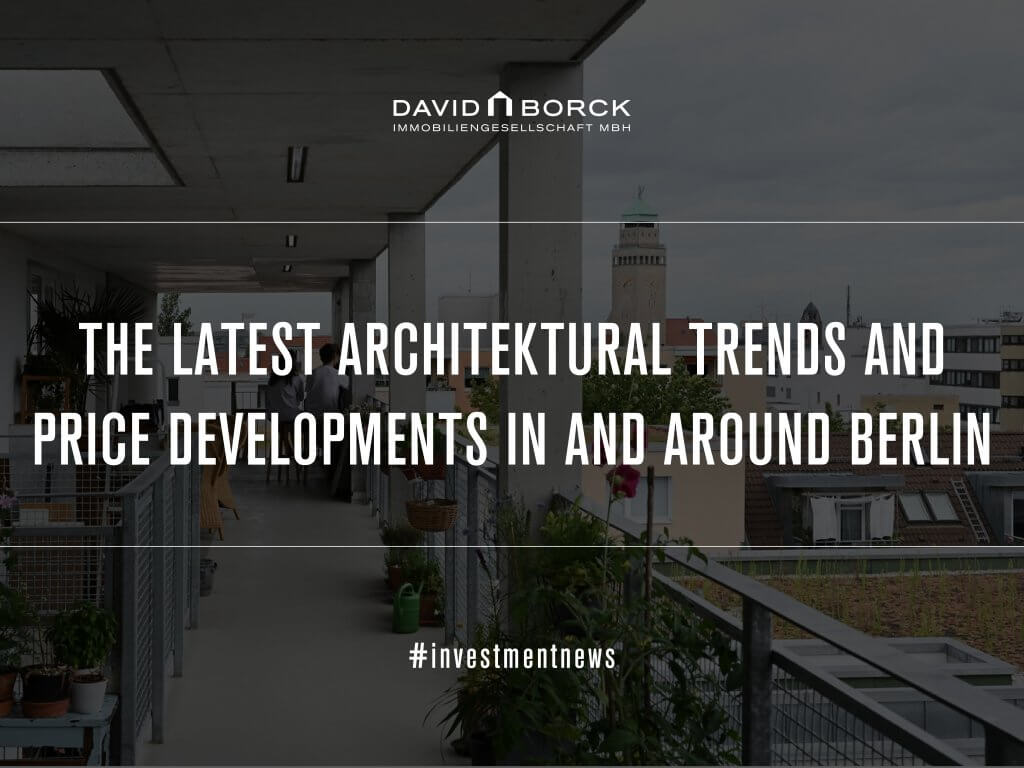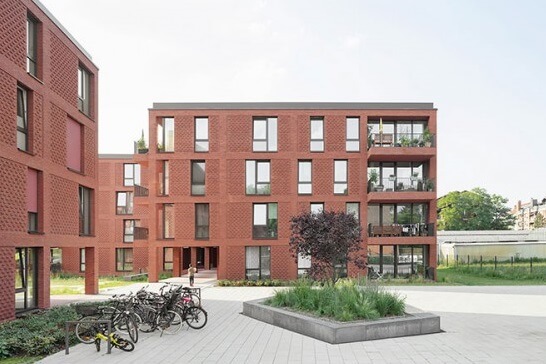
28.02.2022
Allgemein
The latest architectural trends and price developments in and around Berlin
Prices for residential real estate in Germany are rising faster than ever before – and yet it is still profitable to invest in real estate. As the Federal Statistical Office recently announced, prices rose by an average of 12 percent year-on-year from July to September 2021. Above all, real estate in the capital and in Berlin’s suburbs and exurbs is in high demand. The vacancy rate in the region is just 0.8%. The real estate boom looks set to continue unabated.
The coronavirus pandemic has further strengthened this development and, the longer the pandemic lasts, the more people want to own their own homes. As a result, property prices and the demand for owner-occupier housing are on the rise. The working-from-home effect is playing a major role in the latest market developments. More and more Berliners are dreaming of a larger home and many are being drawn out of the city and into the countryside. Another advantage: Compared to the sought-after central locations, prices in these regions are still more affordable.
Property prices continue to rise
In 2020, prospective buyers paid an average of €699,000 and €595,000 respectively for detached and semi-detached homes in Berlin and Potsdam. This represented a healthy increase in both cities – in Potsdam by 18.5 percent compared with the same period of the previous year, and in Berlin by 7.1 percent. The districts bordering Berlin, such as Potsdam-Mittelmark, Havelland, Oberhavel and Dahme-Spreewald, represent the middle of the market, with prices ranging from €399,000 to €449,000. Properties in the districts of Teltow-Fläming, averaging €379,000, and Märkisch-Oderland, at €365,000, are less expensive. However, price increases of 11.5 percent and 13.8 percent respectively show that these regions are also attracting buyers. According to estimates from DZ Bank, the trend will continue in the coming year.
Although the rate at which prices are increasing is expected to lose some momentum, there is currently no reason to expect the real estate bubble to burst, as many are forecasting. The experts at David Borck Immobiliengesellschaft expect the upward trend in residential property prices to stabilize. An investment in real estate will remain attractive, although prices will no longer jump quite so sharply. The market is shifting: The sphere of sought-after residential locations continues to expand, and now includes a radius of up to 50 kilometers around the city center as part of the core catchment area. The city is evolving into a metropolitan region, with strong demand for residential property over amuch wider area.
New architectural trends on the rise
As lifestyle trends evolve, so does architecture. One example is the designs of Dutch architects Francine Houben and Dick van Gameren, whose buildings adapt to the needs of their occupants through their practical and flexible yet highly aesthetic design, and are thus perfectly prepared for unpredictable changes in use – such as those caused by the coronavirus pandemic. Their elegant designs add to occupants’ quality of life, while intelligent floor plans grant residents all the freedom they need to use their properties in an individual and sustainable way. It is no surprise, therefore, that the European Centre for Architecture, Art Design and Urban Studies and the Chicago Athenaeum: Museum of Architecture and Design recently honored the work of Houben and van Gameren with the European Prize for Architecture 2021.
Another trend is sustainability. No wonder, especially as buildings are responsible for a large proportion of CO₂ emissions. French architects Anne Lacaton and Jean-Philippe Vassal have therefore dedicated themselves to improving the CO₂ balance of real estate. The duo restores buildings sustainably – taking into account both the building’s history and the individual needs of its occupants. Transforming and revitalizing a building saves immense amounts of CO₂ and energy that would be consumed during demolition and new construction. They were awarded the Pritzker Architecture Prize in 2021 for their socially and ecologically conscious work.
Focus on inclusive living and urban coexistence
In Germany, too, numerous real estate developments received awards last year. The Berlin-based firm SMAQ Architektur und Stadt, for example, received the German Architecture Award 2021 for its Zusammen Wohnen housing development in Hanover, which transformed a former garden store plot into a heterogeneous urban quarter. On the one hand, four compact structures create a high urban density; on the other, their arrangement creates open spaces that can be designed in a variety of ways, allowing ample sunlight into the quarter and creating a number of attractive visual axes. What makes one of the buildings so unique is that it is home to an inclusive living group, thereby fostering interaction within the building and creating a space that fosters a tangible sense of identity. The building complex is well-balanced – both in terms of what it offers to a variety of users and in the way it blends private and public spaces. As a result, the prize jury observed, the quarter’s outstanding architecture is exemplary in its approach to social coexistence.

A similar example is found at the Neues Wohnen an der Briesestraße development in Berlin. Architect Andrew Alberts has combined a simple block design to create an attractive harmony between buildings, open spaces and paths. These enable easy, neighborly interactions, for example through group cooking or regular discussion groups. After only a short time, an active neighborhood has emerged in the quarter. This extraordinary concept was honored with the BDA Prize Berlin 2021 and has thus proven that a simple new concrete building can also offer incredibly added value for its residents and that, especially during a pandemic, there is no beating neighborly togetherness.

 Back
Back 


